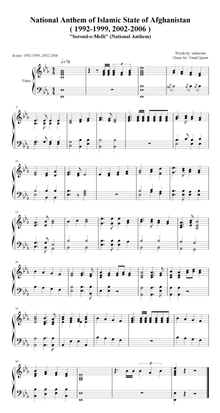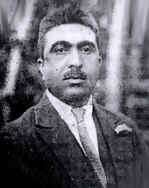Afghan National Anthem
The "Afghan National Anthem" (Pashto: ملی سرود - Millī Surūd; Persian: سرود ملی - Surūde Millī, lit. '"National anthem"') was adopted and officially announced as such by a Loya Jirga in May 2006. According to article 20 of the Afghan constitution, the national anthem shall be in Pashto with the mention of "God is Greatest" as well as the names of the various tribes of Afghanistan.[1] The lyrics were written by Abdul Bari Jahani and the music was written by German-Afghan composer Babrak Wassa.[2]
| English: Afghan National Anthem | |
|---|---|
| Pashto: ملی سرود Dari: سرود ملی | |
National anthem of | |
| Lyrics | Abdul Bari Jahani, 2006 |
| Music | Babrak Wassa, 2006 |
| Adopted | May 2006 |
| Preceded by | "Fortress of Islam, Heart of Asia" |
| Audio sample | |
"Millī Surūd" (instrumental, abridged)
| |
History
National anthem (1926–1943)
 | |
Former national anthem of | |
| Adopted | 1926 |
|---|---|
| Relinquished | 1943 |
Afghanistan's first national anthem was adopted during its period as a monarchy. It was instrumental and had no lyrics.[3]
National anthem (1943–1973)
| English: Grand Salute | |
|---|---|
 | |
Former national anthem of | |
| Lyrics | Mohammed Makhtar, 1943 |
| Music | Mohammed Farukh, 1943 |
| Adopted | 1943 |
| Relinquished | 1973 |
| Audio sample | |
"Grand Salute"
| |
This was Afghanistan's second national anthem, during when it was a monarchy.[4]
National anthem (1973–1978)
| English: National Anthem | |
|---|---|
| Pashto: ملی سرود Dari: سرود ملی | |
Former national anthem of | |
| Lyrics | Abdul Rauf Benawa, 1973 |
| Music | Abdul Ghafoor Breshna, 1973 |
| Adopted | 1973 |
| Relinquished | 1978 |
| Succeeded by | "Garam shah lā garam shah" |
| Audio sample | |
Millī Surūd ملي سرود
| |
A national anthem was adopted in 1973 after the abolition of the Afghan monarchy, when the Republic of Afghanistan was set up by President Daoud Khan. Its lyrics were written by Abdul Rauf Benawa and the music was composed by Abdul Ghafoor Breshna.[5]
National anthem (1978–1992)
| English: National Anthem | |
|---|---|
| Pashto: ملی سرود Dari: سرود ملی | |
.svg.png) | |
Former national anthem of | |
| Also known as | "Garam shah lā garam shah" (English: "Be Ardent, Be More Ardent") |
| Lyrics | Sulaiman Layeq |
| Music | Jalil Zaland, 1978 |
| Adopted | 1978 |
| Relinquished | 1992 |
| Succeeded by | "Fortress of Islam, Heart of Asia" |
| Audio sample | |
Millī Surūd ملي سرود
| |
Another national anthem was adopted after the Democratic Republic of Afghanistan was set up in 1978. Its lyrics were written by Sulaiman Layeq on behalf of the government of the People's Democratic Party of Afghanistan (PDPA) headed by Nur Muhammad Taraki, who decided to change the national symbols after the Marxist coup d'état of 1978.[6][7][8] The music was composed by Jalīl Ghahlānd and was arranged by Ustad Salim Sarmad.[9][10] It is known alternatively by the title of "Garam shah lā garam shah" (English: "Be Ardent, Be More Ardent"), which is also the song's incipit. Like many national anthems, it was sometimes sung abbreviated with only the chorus and the first stanza. In 1987, Afghanistan officially abandoned communism but this song was kept as the national anthem until 1992, when it was discontinued.
National anthem (1992–1999, 2002–2006)
| English: National Anthem | |
|---|---|
| Pashto: ملی سرود Dari: سرود ملی | |
 | |
Former national anthem of | |
| Also known as | قلعه اسلام قلب اسیا (English: "Fortress of Islam, Heart of Asia") |
| Lyrics | Unknown |
| Music | Ustad Qasim, 1919 |
| Adopted | 1992–1999 |
| Readopted | 2002 |
| Relinquished | May 2006 |
| Succeeded by | "Afghan National Anthem" |
| Audio sample | |
transl. ur – transl. ALA-LC ملي سرود
| |

From 1992 to 2006, Afghanistan used a mujahideen battle song composed in 1919 by Ustad Qasim as its national anthem.[11][12] It is also known alternatively by the title "Fortress of Islam, Heart of Asia" (Persian: قلعه اسلام قلب اسیا), which is also the song's incipit.[13][14][15]
During the late 1990s, the Islamic Emirate of Afghanistan under the Taliban took control over most of Afghanistan from the UN-recognized government and ruled most of the country until late 2001. The Taliban outlawed music throughout the territory that they controlled, which consisted of most of the country. As such, most of Afghanistan practically was left without a national anthem during that time, until late 2001 when the Taliban was overthrown. The song was reintroduced by the new transitional government of Afghanistan in 2002;[16] it remained such when the Islamic Republic of Afghanistan was established in 2004 and was used by the latter until 2006.[17][18]
Lyrics
| Pashto Lyrics | Pashto Transliteration | English Translation | Dari Translation | Dari Transliteration |
|---|---|---|---|---|
| First stanza | ||||
|
دا وطن افغانستان دی |
Dā watan Afgānistān dai, |
This land is Afghanistan, |
این کشور افغانستان است |
in kishvar afghānistān ast |
| Second stanza | ||||
|
دا وطن د ټولو كور دى |
Dā watan də ttolo kor dai, |
This is the country of every tribe, |
این کشور خانهٔ همه است |
in kishvar khāni-yi-hame ast |
| Third stanza | ||||
|
ور سره عرب، ګوجر دي |
Wər sara Arəb, Guǰər di, |
With them, there are Arabs and Gujjars, |
هم عرب و گوجر است |
ham arab o gujar ast |
| Fourth stanza | ||||
|
دا هيواد به تل ځلېږي |
Dā hiwād ba təl dzaleγ̌i, |
This land will shine for ever, |
این کشور همیشه تابان خواهد بد |
in kishvar hamēshi tābān khwahda bud |
| Fifth stanza | ||||
|
نوم د حق مو دى رهبر |
Num də haq mo dai rahbar, |
We will follow the one God |
نام حق است ما را رهبر |
nām haq ast mā rā rahbar |
References
- "The Constitution of Afghanistan". afghan-web.com. Retrieved 2013-04-09.
- "National Anthem". afghan-web.com. Archived from the original on 2013-04-11. Retrieved 2013-04-09.
- "Afghanistan (1926-1943)". 6 May 2012.
- "Afghanistan (1943-1973)". 6 May 2012.
- "Afghanistan (1973-1978)". 9 May 2012.
- "State Funeral for Afghan Leader Slain in '78 Coup". The New York Times. 18 March 2009.
- "An Afghan Secret Revealed Brings End of an Era". The New York Times. 1 February 2009.
- The Journal. Rabetat al-Alam al-Islami. 1979. p. 62.
- Visser, Derkwillem (1991). Flaggen, Wappen, Hymnen: Bevölkerung, Religion, Geographie, Geschichte, Verwaltung, Währung (in German). Battenberg. p. 258. ISBN 9783894410445.
- "Afghanistan (1978-1992)". 9 May 2012.
- Bristow, Michael; Lim, Josh; Popp, Reinhard (11 May 2012). "Afghanistan (1992-1999, 2002-2006)". NationalAnthems.info. Retrieved 1 December 2017.
- "National anthems - Islamic State of Afghanistan (1992-2006)". 21 August 2016 – via YouTube.
- "Fortress of Islam, heart of Asia…" – via Amazon.
- "Afghanistan: "Fortress of Islam, Heart of Asia…"" – via Amazon.
- Pigott, Peter (28 February 2007). Canada in Afghanistan: The War So Far. Dundurn. p. 17 – via Internet Archive.
Fortress of Islam, Heart of Asia.
- "Sououd-e-Melli". 15 December 2005. Archived from the original on 15 December 2005.
- "Archived copy". Archived from the original on 2006-10-02. Retrieved 2019-09-18.CS1 maint: archived copy as title (link)
- "National Anthem Downloads, Lyrics, & Information: NationalAnthems.us - Afghanistan: New recording by the composer". www.nationalanthems.us.
External links

- 1992 to 2006 Afghan national anthem
- 1992 to 2006 Afghan national anthem